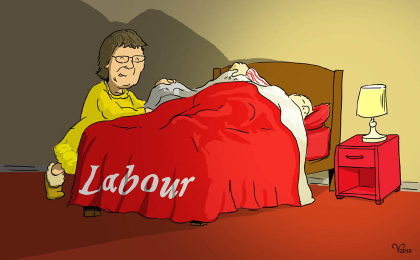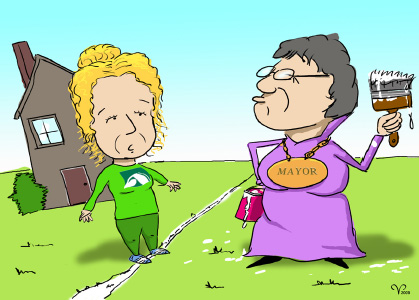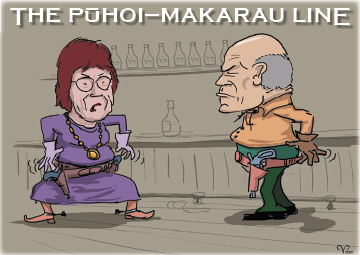Mahurangi Magazine open letter to Labour

The Last Cartoon: At the première of his movie on Monday, filmmaker and cartoonist Craig V Powell was threatened with legal action by the mayor’s husband, should further cartoons depicting her appear. Cartoon Majorlook Productions
Darien Fenton and Phil Twyford
Members of Parliament
Dear Darien and Phil
Regarding Rodney District Council’s private member’s bill.
The Mahurangi Magazine has worked assiduously to encourage involvement of its readers in the process of devising new governance arrangements for the region.
The reason for this dedication is threefold:
- Conviction that any change to the regional democracy should be determined democratically
- The importance of strong regional governance to the Mahurangi since the 1950s
- The importance of strong regional governance to the Mahurangi’s future.
The magazine has pursued these three themes in 18 pieces published since January 2008.
Unfortunately for the region, this exercise in local government reform has managed to repeat the usual mistakes, and make a few new ones. The first serious flaw was the Labour-led government’s failure to specify in the royal commission’s terms of reference:

The Previous Cartoon
Gerrymander Attempt: Curiously, Rodney District Council proposals for a rural ward place the boundary immediately north of regional councillor Christine Rose’s residence. This cartoon earned the editor a summons to appear before the mayor. cartoon Majorlook Productions
- That the commission’s task was to prepare a number of well-developed models for consideration by the people of the region
- That the final choice would be made democratically.
This fundamental deficiency might have been remedied by the commissioners themselves, as did the 1986 Royal Commission on the Electoral System that recommended mixed member proportional be introduced onlysubject to a referendum.
In turn, the response of Rodney District Council has been undemocratic from day one. With no consultation, the district council immediately attacked the regional council including with Wellington billboards. When the district council did belatedly poll residents, in June 2009, it asked a series of shamelessly loaded questions. This question was particularly egregious:
If Rodney District Council was to become part of the Auckland Super City, it is likely that there would be higher level of services but also higher rates. However, if Rodney District Council was not to become part of the Auckland Super City, the council could continue its current level of services with lower rates than the Super City. Which of these options would you prefer? [council emphasis]
The Auckland isthmus conurbation and its rural hinterland has enjoyed the advantages of regional planning since the 1950s. The Mahurangi has particularly benefited. The heads of the harbour, the area most at risk of coastal sprawl development, were protected by acquisition for regional parks.
More recently, in 2004, a major regional council initiative has tackled the elevated sediment accumulation rate that was the likely cause of harbour’s cockles ceasing to breed, in areas that had been continuously studied for 10 years.

The First Cartoon
P Dubya: ‘Mu gobsmackin’ refusal to remain’n yur dirty region’s no gobsmack’d reason to run us outta yur dirty region.’ cartoon Majorlook Productions
On Monday, the community celebrated the launch of the draft of a 20-year strategic plan for the Mahurangi and the première of a short film made to support it. The plan is being developed collaboratively with business, local and district councils, and the community. But, as is usually the case, it is the regional council that responded to the need—the community’s contention was that a longer-term, holistic approach was needed to the supplement the initial five-year focus on riparian fencing and planting. If the district became a unitary authority, this work would wither through lack of funding, as would the work on the Whangateau and Kaipara harbours.
The single greatest threat to the Mahurangi, however, is to its harbourscape of outstanding natural beauty. The sense of the Mahurangi being a million miles from the metropolis is the universal appeal of the place.
Without strong regional planning, the Mahurangi would soon resemble Mangawhai.
This was your party’s view in September 2009, stressing the need to contain coastal development:
The bill proposes to partition Rodney District Council with the southern part joining Auckland and the northern part joining Kaipara District Council. Labour opposes this and supports the Royal Commission’s recommendations that all of Rodney be included in the new Auckland Council. The Royal Commission argued persuasively that the regional boundary must be far enough from the metropolitan urban limit to ensure that non-conforming development does not leap-frog the limit to an area beyond the planning restrictions, thus defeating the purpose of the urban limit. Labour believes that Auckland’s regional parks should stay within Auckland, and that transferring Auckland’s prized northern beaches to the Kaipara District Council would be unlikely to afford them the protection from development they need.
The various bids to split from the metropolis are motivated mostly by ‘less-government’ ideology and ignorance of the role of strong regional governance in resisting coastal sprawl.
The private member’s bill is undemocratically derived and is a wholly unworthy and self-serving contribution to the governance arrangements for region and the Mahurangi. It is also unpopular.
Otherwise at least one person might have spoken in its support, on Monday evening.
Yours faithfully,
Cimino Cole editor
